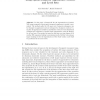BILDMED
2008
14 years 1 months ago
2008
In this paper a framework for the segmentation of cardiac MR image sequences using spatio-temporal appearance models is presented. The method splits the 4D space into 2 separate su...
BILDMED
2008
14 years 1 months ago
2008
For the planning of surgical interventions of the spine exact knowledge about 3D shape and the local bone quality of vertebrae are of great importance in order to estimate the anch...
BILDMED
2008
14 years 1 months ago
2008
Deformable models are used for the segmentation of objects in 3D images by adapting flexible meshes to image structures. The simultaneous segmentation of multiple objects often cau...
BILDMED
2008
14 years 1 months ago
2008
Air holes inside the esophagus can be used to localize the esophagus in computed tomographic (CT) images. In this work we present a technique to automatically detect esophageal air...
BILDMED
2008
14 years 1 months ago
2008
Abstract. The segmentation and visualization of the esophagus is helpful during planing and performing atrial ablation therapy to avoid esophageal injury. Only very few studies hav...
BILDMED
2008
14 years 1 months ago
2008
Manual landmark positioning in volumetric image data is a complex task and often results in erroneous landmark positions. The landmark positioning tool presented uses image curvatu...
BILDMED
2008
14 years 1 months ago
2008
In the clinical environment the segmentation of organs is an increasingly important application and used, for example, to restrict the perfusion analysis to a certain organ. In ord...
BILDMED
2008
14 years 1 months ago
2008
A new method is presented to quantify malignant changes in histological sections of prostate tissue immunohistochemically stained for prostate-specific antigen (PSA) by means of im...
BILDMED
2008
14 years 1 months ago
2008
A major problem in magnetic resonance imaging (MRI) is the lack of a pulse sequence dependent standardized intensity scale like the Hounsfield units in computed tomography. This af...
BILDMED
2008
14 years 1 months ago
2008




